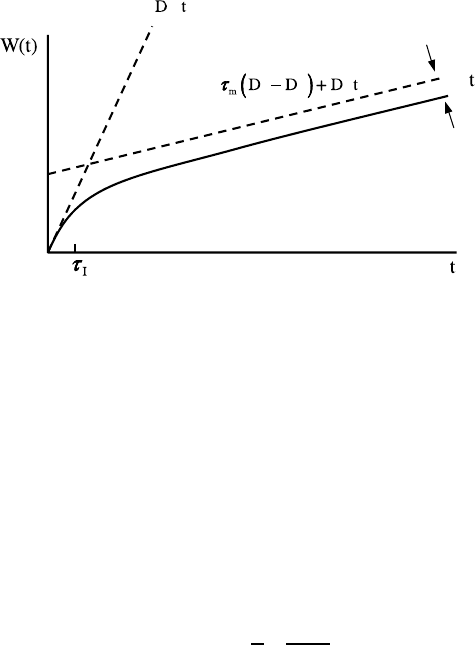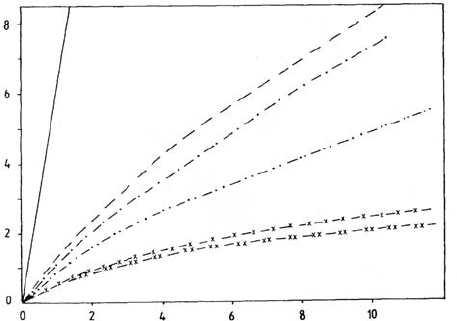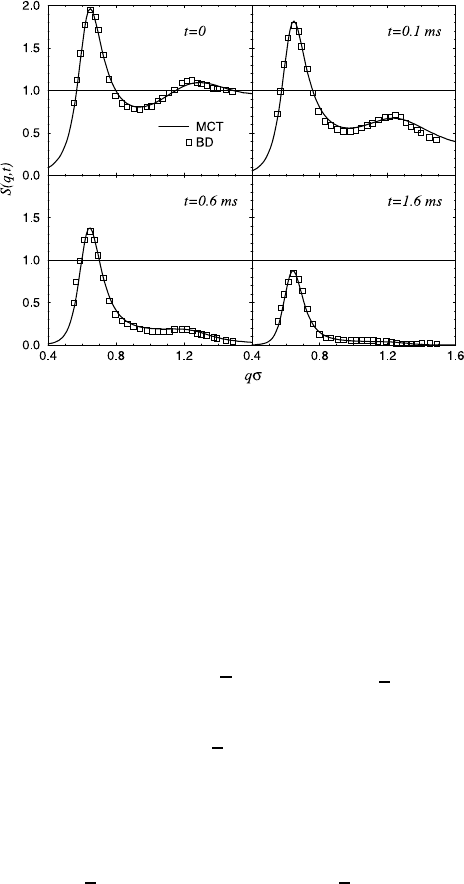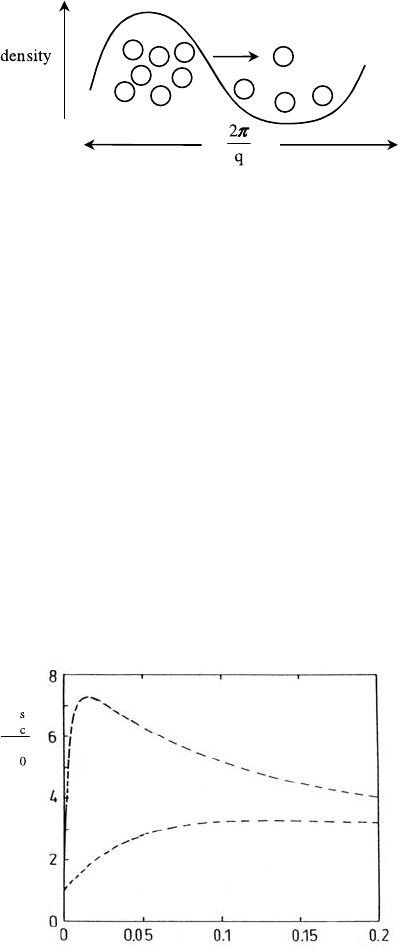Heitjans P., Karger J. (Eds.). Diffusion in Condensed Matter: Methods, Materials, Models
Подождите немного. Документ загружается.


640 Gerhard N¨agele, Jan K. G. Dhont, and Gerhard Meier
l
s
s
s
s
s
s
l
-1/2
~
Fig. 16.6. Mean square displacement in three dimensions (for t τ
B
).
is due to unsteady solvent flow around a sphere in isolation, and appears on
a much shorter time scale t ≈ τ
η
.
The long-time decay of the VAF in one dimension is proportional to
−t
−(d+2)/2
,withd specialized to one. For particles diffusing along an infi-
nite line which are not allowed to pass each other (single-filing condition)
there is, however, a subtle difference to diffusion in higher dimensions. Due
to the strong mutual hindrance of particles moving along a line the MSD at
long times grows only proportional to t
1/2
. Without HI, the MSD reads thus
explicitly [16]
W (t) →
⎧
⎨
⎩
2D
0
t, τ
B
t τ
I
1
n
4D
0
t
π
1/2
,t τ
I
(16.80)
with n denoting the line density of particles and interaction time τ
I
=
1/(D
0
n
2
). It is most likely that only the pre-factor of t
1/2
will be affected
when HI is included. The long-time limiting form of the pdf, P (x, t), for a
particle displacement x during time t is given by the Gaussian form in (16.40)
for d =1,withW (t) according to (16.80) for t τ
I
. The absence of a linear
long-time term in W (t) implies a vanishing long-time self-diffusion coefficient
for an infinite line. Single-file diffusion can be observed, e.g., in superionic
conduction, in diffusion of bio-molecules through narrow-sized channels in
membranes and in zeolites of one-dimensional channel structure (cf., e.g.,
Chap. 10, Fig. 10.7, and Chap. 18, (18.107)).
Self-diffusion coefficients can be measured by scattering experiments or
by means of specialized techniques that use fluorescently labelled spheres
(which will be discussed separately later in this chapter). To measure self-
diffusion over an extended time range the system now consists of a possibly
concentrated suspension of host spheres, with a few tracer spheres, such that
the tracer spheres do not mutually interact with each other. The system

16 Diffusion in Colloidal and Polymeric Systems 641
must be prepared such that the scattered intensity from the host particles
and the solvent molecules can be neglected against that of the tracer parti-
cles. As explained in Sect. 16.2.2, the measured EACF is proportional to the
self-dynamic structure factor S
s
(q, t) defined in (16.27), provided tracer and
host spheres are different from each other only in terms of their scattering
properties.
The self-dynamic structure factor may be expanded in a Taylor series for
small wavevectors,
S
s
(q, t)=1−
1
6
q
2
|r(t =0)−r(t)|
2
+ O(q
4
) , (16.81)
meaning that
S
s
(q, t)=exp{−q
2
W (t)}
!
1+O(q
2
)
"
. (16.82)
There is a time-dependent non-Gaussian correction of O(q
2
)toS
s
(q, t)orig-
inating from particle interactions. This correction is rather small for a fluid-
like suspension and becomes zero when the small-q limit is considered. Equa-
tion (16.82) allows for measuring the full time-dependence of the MSD. To
this end, −ln{S
s
(q, t)}/q
2
is plotted for a given time t against q
2
, and linearly
extrapolated to q = 0. The intercept is equal to W (t). Such data obtained
from dynamic light scattering experiments on hard-sphere suspensions are
given in Fig. 16.7, for various volume fractions [17]. The cross-over from
short- to long-time behavior is clearly seen. Further note the diminishing dif-
ference between the short- and long-time self-diffusion coefficients when the
concentration is decreased.
At infinite dilution, D
s
s
= D
0
, W (t)=D
0
t and
S
s
(q, t)=exp{−q
2
D
0
t}, (16.83)
which is the dynamic structure factor describing the single-particle diffusion
of independent particles.
Collective Diffusion
In contrast to self-diffusion, which is the Brownian motion of a tagged parti-
cle in a sea of others, collective diffusion refers to the isothermal relaxation
of density gradients by the coordinated motion of many colloidal particles.
Imagine a colloidal system where the density of colloidal particles, at some
instant in time, varies sinusoidally (such a sinusoidal density profile is referred
to as a density wave or density mode). That is, at time t =0say,thenumber
density
ρ(r,t= 0) at position r is equal to
ρ
q
(r,t=0) = ρ
0
+ ρ(q,t=0)sin{q · r} (16.84)
with ρ
0
= N/V the average number density, and ρ(q,t = 0) the ampli-
tude of the density wave. The bar indicates an ensemble average over a

642 Gerhard N¨agele, Jan K. G. Dhont, and Gerhard Meier
0.384
0.444
0.494
0.539
0.411
~0
t 10 s
2
Wt( ) 10 ( m)
2
3
Fig. 16.7. Mean square displacement W (t) of silica tracer spheres in an index-
matched host suspension of PMMA spheres (of same size as the silica particles). The
curves are labelled by volume fraction Φ. The last two volume fractions represent the
co-existing fluid (Φ
freez
=0.494) and crystalline (φ
melt
=0.539) phases. After [17].
non-equilibrium initial particle distribution. The wavevector q determines
both the direction and the wavelength of the sinusoidal density variation.
For changes of the position r in the suspension perpendicular to q, the phase
of the sine function does not change, so that the direction of q is in the “prop-
agation direction” of the sinusoidal variation. A change ∆r of the position r
parallel to q leaves the sine function unchanged when |∆r |= m ×2π/q,with
m an arbitrary integer. Hence, the wavelength of the density variation is
Λ =2π/q . (16.85)
The density wave will relax away to the homogeneous state due to the collec-
tive motion of particles. In the initial stage of relaxation (i.e. for τ
B
t τ
I
),
the decay of the density wave is single-exponential in time. At a later stage
(t ≈ τ
I
) the decay becomes non-exponentially and slower than initially as a
result of interactions between the colloidal particles. In the final long-time
regime (t τ
I
), the density variation may decay once again exponentially
in time for selected values of q, however with a decay rate that is usually
smaller than the initial one. For a density wave of large amplitude, different
wavelengths come into play at a later stage and its shape is then no longer si-
nusoidal. Long-time collective diffusion describes the final stage of relaxation
of a density wave, where the density profile generally strongly deviates from
a sinusoidal profile.
A phenomenological description of the relaxation of density waves can
be accomplished by using what is known as generalized hydrodynamics. The
starting point in a generalized hydrodynamic description is the continuity

16 Diffusion in Colloidal and Polymeric Systems 643
equation
∂
∂t
ρ(r,t)=−∇ ·j(r,t) , (16.86)
which relates the particle density to the particle flux density,
j(r,t), and it
expresses the conservation of the number of particles. The overbar indicates
an average over a non-equilibrium ensemble. The flux density
j(r,t)denotes
the number of colloidal particles that cross the point r in the direction in
which
j points, per unit area and unit time.
For small amplitudes in the density variation, and close to thermal equi-
librium, the flux is linearly related to gradients in the density, that is (note
that at time t = 0 relaxation begins)
j(r,t)=−
dr
t
0
dt
D
c
(r − r
,t− t
) ·∇
ρ(r
,t
) , (16.87)
where the integral kernel tensor D
c
(r,t) is referred to as the real-space col-
lective diffusion kernel. This phenomenological expression can be interpreted
as the leading term in an expansion of the flux
j with respect to the ampli-
tude of density gradients. The “Taylor coefficient” D
c
is independent of the
magnitude of gradients whenever these are sufficiently small. Density modes
of different wave numbers decay then independently from each other due to
linearity in
ρ(r,t). The non-local space and time dependence of j on ∇ρ can
be understood as follows. The flux at a point r can depend on density gra-
dients at another point r
, through interactions between the spheres. Hence,
D
c
(r − r
,t− t
)=0when| r − r
| R
I
,whereR
I
is a measure for the
distance over which colloidal particles are correlated. Moreover, the flux at
time t can depend on ∇
ρ at earlier times, due to the finite time it takes in-
teractions to propagate. Such time-delayed effects are commonly referred to
as memory effects. As a consequence, D
c
(r −r
,t−t
)=0whent −t
τ
I
.
Note that causality requires that D
c
(r,t) = 0 whenever t<0. The diffusion
kernel is a tensor since flux and density gradient may not be collinear. Spatial
isotropy requires further that D
c
(r,t)=D
c
(|r|,t). The so-called non-local
Fickian law in (16.87) is valid on a mesoscopically coarse-grained level of
spatial resolution ∼ (D
0
τ
I
)
1/2
and time resolution ∼ τ
I
.
Spatial Fourier transformation of (16.86) with the use of (16.87) leads to
∂
∂t
ρ(q,t)=−q
2
t
0
dt
D
c
(q, t − t
) ρ(q,t
) . (16.88)
where D
c
(q, t)=
ˆ
q · D
c
(q, t) ·
ˆ
q is the longitudinal part (parallel to q)of
the Fourier transform of the diffusion kernel, and
ˆ
q = q/q. For notational
brevity we use the same symbols for the original and Fourier transformed
functions, where their argument (either r or q) indicates which function is
meant. Spatial isotropy requires the Fourier transform of D
c
(r,t) to depend
only on the magnitude q of the wavevector q. We learn from (16.88) that

644 Gerhard N¨agele, Jan K. G. Dhont, and Gerhard Meier
the time rate of change of a density mode becomes increasingly slow with
decreasing wavenumber, since particles need to diffuse over an increasingly
large distance Λ =2π/q to smooth out density variations.
According to the definition of the collective dynamic structure factor, we
find from (16.88) (using that the non-equilibrium average density
ρ satisfies
near equilibrium the same linear equation of motion as the equilibrium den-
sity autocorrelation function, which is known as an application of Onsager’s
hypothesis) that
∂
∂t
S
c
(q, t)=− q
2
t
0
dt
D
c
(q, t − t
)S
c
(q, t
) . (16.89)
The solution of this equation for S
c
can be formulated in terms of time-
Laplace transforms. The Laplace transform of a function f is defined as
f(z) ≡
∞
0
dtf(t)exp{−zt} . (16.90)
In terms of such Laplace transforms, the solution of (16.89) reads
S
c
(q, z)=
S
c
(q)
z + q
2
D
c
(q, z)
(16.91)
with a wavenumber and frequency (i.e. z) dependent collective diffusion ker-
nel D
c
(q, z). As explained above, the q-dependence of D
c
(q, z) describes the
coupling between the colloidal particle flux at a certain point with density
gradients at other points. The z-dependence of D
c
describes memory effects,
that is, the coupling between the flux at a certain time with density gradi-
ents that existed at earlier times. For strongly interacting particles memory
effects give rise to a complicated time-dependence of S
c
(q, t), characterized by
a whole spectrum of relaxation times. The collective dynamic structure factor
(as well as S
s
(q, t)) is a strictly monotonically decaying function in time, for
fixed q, with negative slope (d/dt)S
c
(q, t) < 0. This exemplifies an impor-
tant rule stating that any autocorrelation function is strictly monotonically
decaying in time when described within the overdamped colloid dynamics,
i. e., for t τ
B
[18]. It follows readily that S
c
(q, z) > 0andzS
c
(q, z) <S(q).
These inequalities in turn imply with (16.91) that D
c
(q, z) and its associated
collective diffusion coefficients are all non-negative, as one expects on phys-
ical grounds. For fixed t, S
c
(q, t) shows damped oscillations in q.Atypical
q-dependence of S
c
(q, t)atvarioust is illustrated in Fig. 16.8, which shows
theoretical and computer simulation results of S
c
(q, t)forasuspensionof
charge-stabilized colloidal spheres.
There exists a special regime where (16.91) predicts an exponential decay
of S
c
(q, t). In this so-called hydrodynamic regime, only density wave relax-
ations are resolved with a wavelength much larger than R
I
(typically ∼ 1
mm), and with a time resolution that is much larger than τ
I
(typically ∼

16 Diffusion in Colloidal and Polymeric Systems 645
Fig. 16.8. Collective dynamic structure factor of a charge-stabilized colloidal dis-
persion. Open squares: Brownian dynamics (BD) computer simulations (from [19]);
solid line: Mode coupling theory (MCT) result.
1 s). On this strongly coarse-grained level, one can neglect non-local spatial
dependencies and memory effects. The collective diffusion kernel is then equal
to
D
c
(r − r
,t− t
)=D
l
c
1 δ(r − r
) δ(t − t
) . (16.92)
The coefficient D
l
c
is independent of position and time when the amplitude
of the density profile is sufficiently small. Hence, from (16.87),
j(r,t)=−D
l
c
∇ ρ(r,t) , (16.93)
which is Fick’s local law of macroscopic gradient diffusion. S
c
(q, t)andthe
associated density wave
ρ
q
(r,t) in (16.84) decay thus exponentially, for q
R
I
−1
and t τ
I
, according to
S
c
(q, t)=S
c
(q)exp{−q
2
D
l
c
t} (16.94)
and
ρ
q
(r,t)=ρ
0
+exp{−q
2
D
l
c
t} ρ(q,t=0)sin{q · r} (16.95)
respectively, where S
c
(q)=S
c
(q, t = 0) is the static structure factor. The
correlation length R
I
can be roughly estimated by 1/q
m
,whereq
m
is the wave
number where the static structure factor attains its principal maximum. The
average extension of the next-neighbor cage around a sphere is roughly equal
to 2π/q
m
. The local microstructure around a sphere is not resolved in the
hydrodynamic limit. This means that S
c
(q q
m
) in (16.94) is practically
equal to the long-wavelength limit

646 Gerhard N¨agele, Jan K. G. Dhont, and Gerhard Meier
S
c
(0) ≡ lim
q→0
S
c
(q)=ρ
0
k
B
Tχ
T
with χ
T
=
1
ρ
0
∂ρ
0
∂p
T
, (16.96)
where, for a one-component suspensions, χ
T
is the isothermal osmotic com-
pressibility of colloidal spheres.
The transport coefficient D
l
c
is referred to as the long-time collective or
gradient diffusion coefficient, since it can be determined, e.g., from macro-
scopic gradient diffusion experiments near equilibrium. Note here that (16.94)
is equivalent to
S
c
(q, z)=
S
c
(0)
z + q
2
D
l
c
. (16.97)
which shows with (16.91) that D
l
c
is equal to the small-wavenumber and
small-frequency (i.e. long-time) limit of the collective diffusion kernel. Ex-
plicitly
D
l
c
= lim
z→0
lim
q→0
D
c
(q, z) , (16.98)
where q
2
/z (i.e. q
2
t) is kept fixed to a value of order one. The long-time
(i.e. zero-frequency) limit t →∞(i.e. z → 0) means in physical terms that
t τ
I
(i.e. z τ
−1
I
). Likewise, the short-time (infinite-frequency) limit
t → 0(z →∞) should be interpreted as τ
B
t τ
I
(τ
I
−1
z τ
−1
B
).
As a phenomenological approach, generalized hydrodynamics provides no
methods to predict the collective diffusion kernel D
c
(q, z) and its associ-
ated long-time diffusion coefficient D
l
c
. An actual calculation of D
c
(q, z)can
be accomplished only on the basis of a microscopic theory that relies on a
many-sphere extension of the single-particle diffusion equation (16.45) as the
appropriate time evolution equation. A microscopic theory of diffusion will be
discussed in Sect. 16.5. We will address here only general features of collective
diffusion.
At short times, τ
B
t τ
I
, memory effects are not felt yet and
S
c
(q, t)=S
c
(q)exp{−q
2
D
s
c
(q)t}, (16.99)
i. e. there is an exponential short-time decay of S
c
(q, t) for all q. We recall
that short-time collective diffusion relates to the initial stage of relaxation of
a density wave, where it still retains its original form, but just has decreased
its amplitude. This process is described by a wavenumber-dependent (i.e.
apparent) diffusion coefficient D
s
c
(q)=D
c
(q, z →∞) which quantifies the
initial de-correlation of density modes of wavenumber q. Equation (16.99) and
the monotonicity of S
c
(q, t) imply that the longitudinal collective diffusion
kernel in (16.89) is decomposable as [18,20]
D
c
(q, t)=2D
s
c
(q)δ(t) − ∆D
c
(q, t) , (16.100)
corresponding to
∂
∂t
S
c
(q, t)=−q
2
D
s
c
(q)S
c
(q, t)+q
2
t
0
dt
∆D
c
(q, t−t
)S
c
(q, t
) , (16.101)

16 Diffusion in Colloidal and Polymeric Systems 647
with a memory function contribution ∆D
c
(q, t) ≥ 0. The non-local memory
effect on density relaxations inherent in ∆D
c
(q, t) is operative only for times
exceeding the short-time regime, and it causes a slower and, in general, non-
exponential decay of S
c
(q, t).
The short-time collective diffusion coefficient is defined as the zero-q limit
of the apparent diffusion coefficient
D
s
c
= lim
q→0
D
s
c
(q) , (16.102)
and relates to the long-time collective diffusion coefficient through
D
l
c
= D
s
c
− lim
q→0
∞
0
dt∆D
c
(q, t) . (16.103)
The collective diffusion coefficients obey thus the same ordering
D
l
c
≤ D
s
c
(16.104)
as the short-time and long-time self-diffusion coefficients. The coefficient D
l
c
quantifies the relaxation of constant density gradients over times t τ
I
,
through cooperative diffusion of spheres opposite to the gradient direction
ˆ
q. Therefore D
l
c
is intimately related to the average sedimentation velocity,
U
l
, as measured in a homogeneous suspension of slowly sedimenting colloidal
spheres. To understand this explicitly, consider a homogeneous suspension
of equal spheres in a closed vessel which sediment slowly (so that Pe ≡
U
l
a/D
0
0) under the influence of a constant force of buoyancy F = F
ˆ
q.
This force acting on each sphere drives a sedimentation flux
j
s
= ρ
0
U
l
ˆ
q . (16.105)
At equilibrium, the small concentration gradient, ∇
ρ, thereby generated will
produce an equal, but opposite diffusive flux, j
d
,sothat
0=j
s
+ j
d
= ρ
0
U
l
ˆ
q − D
l
c
∇ρ. (16.106)
The force on the solvent exerted by the sedimenting particles is balanced
through a pressure gradient, ∇p = ρ
0
F , generated by the base of the vessel
(which is perpendicular to
ˆ
q). The pressure gradient drives a back-flow of
solvent such that the zero-volume-flux condition is fulfilled: due to incom-
pressibility, the net volume flux of solvent and spheres through any plane
perpendicular to
ˆ
q is zero. The concentration gradient (at constant temper-
ature and chemical potential) follows next from
∇
ρ =
∂ρ
0
∂p
T, µ
s
∇p = βS
c
(0)ρ
0
F
ˆ
q . (16.107)
Finally, substitution into (16.106) leads to the general relation [21, 22]

648 Gerhard N¨agele, Jan K. G. Dhont, and Gerhard Meier
D
l
c
=
D
0
S
c
(0)
U
l
U
0
(16.108)
between D
l
c
and U
l
,whereU
0
= βD
0
F is the sedimentation velocity at
infinite dilution. Equation (16.108) can be derived more rigorously from linear
response theory, which provides us further with a microscopic expression for
D
l
c
.
Very interestingly, the configurational pdf of identical colloidal spheres is
not distorted from the equilibrium distribution during sedimentation, as long
as HI between spheres can be considered as pairwise additive. This holds true
for dilute monodisperse suspensions. The long-time sedimentation velocity
U
l
, which is measured in standard sedimentation experiments, becomes then
equal to the short-time sedimentation velocity U
s
. The latter is related to
the short-time collective diffusion coefficient once again by (16.108), with l
replaced by s.Consequently
D
l
c
= D
s
c
(16.109)
for pairwise-additive HI. There is thus no distinction between short-time
and long-time collective diffusion, which corresponds to a vanishing memory
contribution to D
l
c
in (16.103). A density wave retains its sinusoidal shape
during the entire process of relaxation whenever the wavelength is much
larger than the correlation length R
I
. This result is in marked difference
to self-diffusion where the long-time self-diffusion coefficient of interacting
particles is substantially smaller than the short-time one even when HI is
totally disregarded.
Three-body or more-body HI become highly relevant for concentrated
dispersions. In these systems, their effect is to distort the suspension mi-
crostructure from the initial equilibrium distribution for times t ∼ τ
I
,which
causes additional hindrance of particle motion. For t τ
I
,anewsteady-
state distribution has been reached, accompanied by a small decrease in the
sedimentation velocity such that U
l
<U
s
and D
l
c
<D
s
c
. Recent calculations
for dense hard-sphere suspensions have revealed, however, that the differ-
ences between D
l
c
and D
s
c
are quite small (less than 6%), which makes them
difficult to detect using DLS [23].
DLS and small-angle quasielastic neutron scattering experiments on col-
loidal particles which scatter equally strongly, are convenient and widely used
tools to determine S
c
(q, t) over an extended range of times and wave num-
bers. These methods allow one to study in detail relaxation of density waves
for a wavelength set by the experimental scattering angle. The short-time
and long-time collective diffusion coefficients can be extracted from linearly
extrapolating −ln{S
c
(q, t)}/q
2
, measured for fixed t τ
I
and t τ
I
, respec-
tively, to q = 0. The sedimentation velocity derives then from (16.108) when
in addition S
c
(q q
m
) is determined by static light scattering.
In dispersions of strongly repelling particles, D
s
c
and D
l
c
can be substan-
tially larger than the Stokesian diffusion coefficient D
0
. This feature is mainly

16 Diffusion in Colloidal and Polymeric Systems 649
Fig. 16.9. Enhanced relaxation of density fluctuations through low osmotic com-
pressibility.
due to the low osmotic compressibility (i.e. S
c
(0) 0), which acts as a ther-
modynamic force driving the relaxation of local density gradients (cf. Fig.
16.9).
A typical concentration dependence of D
s
c
for a suspension of moderately
charged colloidal spheres and for a suspension of uncharged hard spheres is
shown in Fig. 16.10. Note that both S
c
(0) and U
s
decrease with increas-
ing volume fraction Φ of spheres (cf. (16.108)). At small volume fraction Φ,
U
s
decreases less strongly than S
c
(0) leading to an initial increase in D
s
c
.
With Φ further increasing, hydrodynamic hindrance starts to overcompen-
sate the electrostatic particle repulsion so that D
s
c
goes through a maximum.
The maximum in D
s
c
(φ) becomes smaller with increasing amount of added
electrolyte, i.e. with enlarged screening of the electrostatic repulsion. While
D
s
s
/D
0
≤ 1 independent of the type of interactions, D
s
c
/D
0
is found to be
larger than one for repulsive pair interactions. For dispersions with attractive
interaction contributions close to a critical point, however, D
s
c
/D
0
≈ 0 due
D
D
a
b
Fig. 16.10. Theoretical prediction for the (reduced) collective diffusion coefficient
D
s
c
/D
0
versus volume fraction, for typical aqueous solutions of weakly charged
spherical micelles. Shown are two curves with (a) low amount and (b) moderately
large amount of added electrolyte. After [18].
